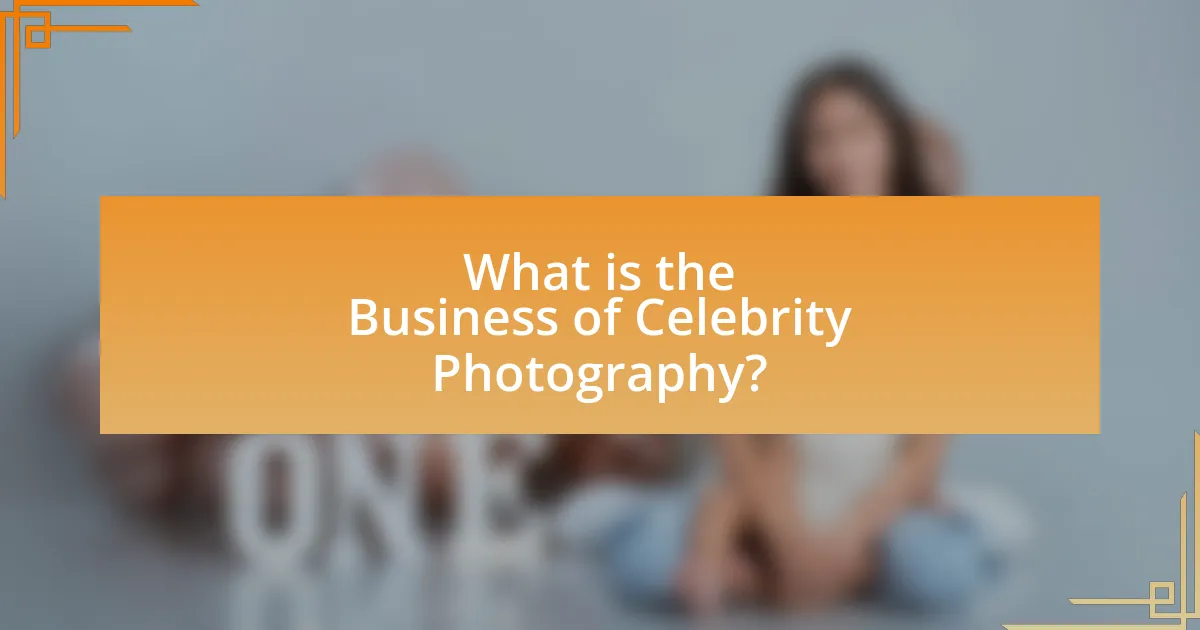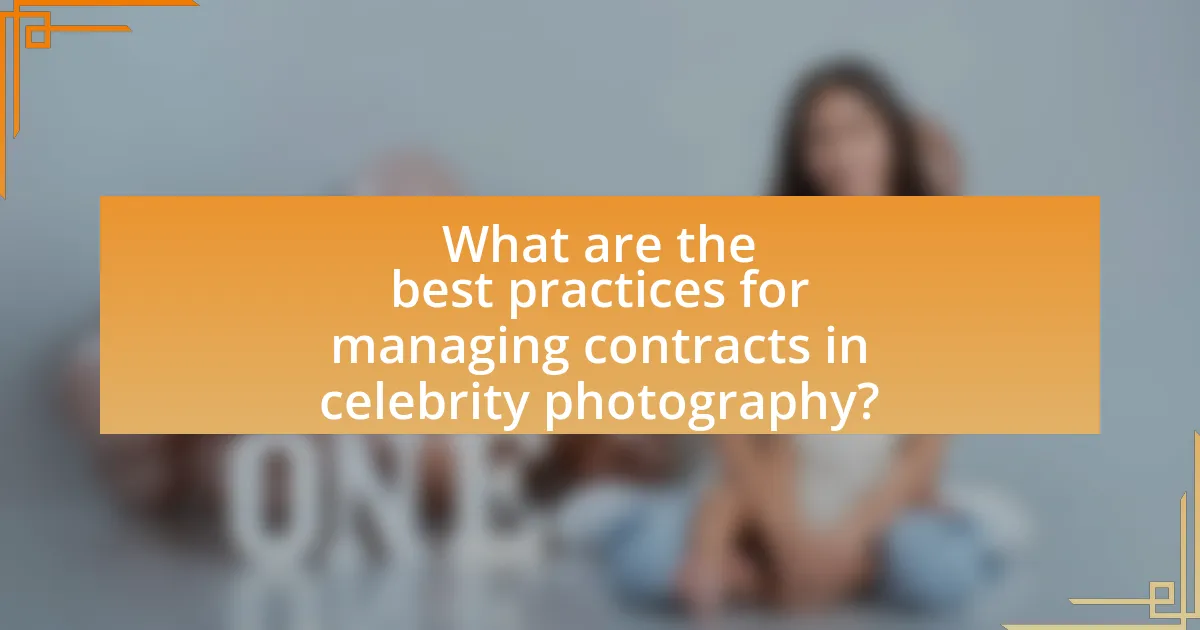The article focuses on the business of celebrity photography, emphasizing the unique legal and ethical considerations that differentiate it from other photography genres. It explores the challenges photographers face, including privacy issues, access to subjects, and the complexities of contracts and rights management. Additionally, the impact of social media on celebrity photography is examined, highlighting the shift towards real-time content and the need for photographers to adapt. Key elements of celebrity photography contracts, including usage rights and compensation, are discussed, along with best practices for navigating legal complexities and ensuring fair compensation. The article also addresses emerging trends and technologies shaping the industry, providing practical tips for photographers to succeed in this competitive field.

What is the Business of Celebrity Photography?
The business of celebrity photography involves capturing images of public figures for commercial purposes, including magazines, advertisements, and social media. This sector thrives on the demand for exclusive and high-quality images that can enhance a celebrity’s brand and appeal to their audience. According to a report by IBISWorld, the photography industry, which includes celebrity photography, generates billions in revenue annually, driven by the rise of digital media and the increasing importance of visual content in marketing strategies.
How does celebrity photography differ from other photography genres?
Celebrity photography differs from other photography genres primarily in its focus on public figures and the unique legal and ethical considerations involved. Unlike general portrait or landscape photography, celebrity photography often requires navigating complex contracts, rights to publicity, and privacy issues due to the high-profile nature of the subjects. For instance, photographers must obtain explicit permission to use images of celebrities for commercial purposes, as established by various legal precedents that protect a celebrity’s image and likeness. This legal framework is not typically a concern in other photography genres, where such permissions are less stringent or not required at all.
What unique challenges do celebrity photographers face?
Celebrity photographers face unique challenges primarily related to privacy, access, and legal rights. The nature of their work often involves capturing images of public figures who are highly protective of their personal lives, leading to difficulties in obtaining consent and access to subjects. Additionally, navigating complex contracts and rights issues is crucial, as photographers must ensure they have the legal permissions to use images commercially, which can vary significantly based on the celebrity’s preferences and the agreements in place. For instance, high-profile celebrities may have specific clauses in their contracts that restrict how and where their images can be published, complicating the photographer’s ability to monetize their work effectively.
How has the rise of social media impacted celebrity photography?
The rise of social media has significantly transformed celebrity photography by increasing the demand for real-time, candid images shared directly with fans. This shift has led to a decline in traditional paparazzi photography, as celebrities often post their own content, controlling their image and narrative. According to a study by the Pew Research Center, 72% of adults use social media, which has created a platform where celebrities can engage with their audience without intermediaries, thus altering the dynamics of how celebrity images are captured and distributed.
What role do contracts play in celebrity photography?
Contracts in celebrity photography serve as legal agreements that define the rights and responsibilities of both photographers and the celebrities being photographed. These contracts typically outline usage rights, compensation, and the scope of the work, ensuring that both parties have a clear understanding of how the images can be used and distributed. For instance, a contract may specify whether the photographs can be used for commercial purposes, editorial content, or promotional materials, thereby protecting the interests of the celebrity’s brand and the photographer’s creative work. Additionally, contracts help mitigate potential disputes by providing a legal framework for addressing issues such as unauthorized use or breach of terms, which is crucial in an industry where image rights are highly valued.
What are the essential elements of a celebrity photography contract?
The essential elements of a celebrity photography contract include the scope of work, compensation details, usage rights, exclusivity clauses, and termination conditions. The scope of work specifies the type of photography services to be provided, while compensation details outline the payment structure, including fees and any additional expenses. Usage rights define how the photographs can be used, including any limitations on distribution or publication. Exclusivity clauses may prevent the photographer from working with competing clients for a specified period, and termination conditions outline the circumstances under which either party can end the contract. These elements are crucial for protecting the interests of both the photographer and the celebrity, ensuring clarity and legal compliance in the business arrangement.
How can photographers protect their rights through contracts?
Photographers can protect their rights through contracts by clearly defining ownership, usage rights, and compensation terms within the agreement. A well-drafted contract specifies that the photographer retains copyright over their images, outlines how the images can be used by the client, and establishes payment structures, including any royalties or licensing fees. For instance, including clauses that limit the scope of use to specific media or timeframes can prevent unauthorized exploitation. Contracts also serve as legal evidence in disputes, reinforcing the photographer’s rights and intentions.
Why are rights and permissions crucial in celebrity photography?
Rights and permissions are crucial in celebrity photography because they protect the legal interests of both the photographer and the celebrity. Without obtaining explicit consent, photographers risk facing legal repercussions such as lawsuits for invasion of privacy or copyright infringement. For instance, the case of “Elder v. McGraw-Hill” highlighted the importance of securing rights, where a photographer was sued for using a celebrity’s image without permission, resulting in significant financial penalties. Therefore, securing rights and permissions ensures that the photographer can use the images commercially while respecting the celebrity’s personal rights and image.
What types of rights should photographers be aware of?
Photographers should be aware of copyright, model release, and property rights. Copyright grants photographers exclusive rights to their images, allowing them to control reproduction and distribution. Model release rights are essential when photographing individuals, as they provide legal permission to use the likeness of the person in the images. Property rights come into play when photographing private property, requiring permission from the property owner to avoid legal issues. Understanding these rights is crucial for photographers to protect their work and avoid potential legal disputes.
How do licensing agreements work in the context of celebrity photography?
Licensing agreements in celebrity photography allow photographers to grant permission for the use of their images under specific terms. These agreements typically outline the scope of use, duration, and compensation, ensuring that both the photographer’s rights and the client’s needs are met. For instance, a photographer may license an image for editorial use in a magazine, specifying that the image cannot be used for commercial purposes without further negotiation. This legal framework protects the intellectual property of the photographer while providing clients with the necessary rights to utilize the images as agreed.
How can photographers navigate the complexities of contracts and rights?
Photographers can navigate the complexities of contracts and rights by thoroughly understanding the legal terms and conditions outlined in their agreements. This involves reviewing key elements such as copyright ownership, usage rights, and compensation structures. For instance, photographers should ensure they retain copyright to their images unless explicitly transferred, as this protects their ability to control how their work is used. Additionally, they should clarify the scope of usage rights granted to clients, specifying whether the images can be used for commercial purposes, social media, or editorial content. Familiarity with industry standards and consulting legal professionals when necessary can further aid photographers in making informed decisions and avoiding potential disputes.
What are the common pitfalls in celebrity photography contracts?
Common pitfalls in celebrity photography contracts include vague terms regarding usage rights, inadequate compensation clauses, and lack of clarity on exclusivity agreements. Vague terms can lead to disputes over how images may be used, potentially resulting in unauthorized exploitation. Inadequate compensation clauses may not reflect the value of the work or the celebrity’s marketability, leading to financial losses for the photographer. Additionally, unclear exclusivity agreements can restrict a photographer’s ability to work with other clients, limiting their income potential. These issues highlight the importance of precise language and thorough negotiation in contracts to protect the interests of photographers.
How can photographers avoid legal issues related to rights and permissions?
Photographers can avoid legal issues related to rights and permissions by obtaining explicit written consent from subjects before capturing their images. This practice ensures that photographers have the necessary rights to use the photographs for specific purposes, thereby minimizing the risk of legal disputes. Additionally, familiarizing themselves with copyright laws and understanding the distinctions between commercial and editorial use can further protect photographers. For instance, the U.S. Copyright Office states that copyright protection is automatic upon the creation of a work, but obtaining model releases is crucial for commercial use to avoid claims of invasion of privacy or misappropriation of likeness.

What are the best practices for managing contracts in celebrity photography?
The best practices for managing contracts in celebrity photography include clearly defining the scope of work, ensuring all parties understand usage rights, and maintaining organized documentation. Clearly defining the scope of work prevents misunderstandings regarding deliverables, timelines, and payment terms. Ensuring all parties understand usage rights is crucial, as it protects both the photographer’s and the celebrity’s interests regarding how images can be used, published, or distributed. Maintaining organized documentation, including signed contracts and correspondence, facilitates easy reference and compliance with agreed terms. These practices help mitigate legal disputes and foster professional relationships in the celebrity photography industry.
How can photographers ensure they are fairly compensated?
Photographers can ensure they are fairly compensated by establishing clear contracts that outline payment terms, usage rights, and deliverables. Contracts serve as legal agreements that protect both the photographer and the client, specifying the scope of work and the compensation structure. According to the American Society of Media Photographers, having a written agreement can prevent disputes and clarify expectations, which is crucial in the competitive field of celebrity photography. Additionally, photographers should research industry standards for pricing and consider factors such as experience, project complexity, and market demand to set fair rates.
What strategies can be employed to negotiate better contract terms?
To negotiate better contract terms, one effective strategy is to conduct thorough research on industry standards and comparable contracts. This preparation allows photographers to understand typical compensation, usage rights, and deliverables, which strengthens their position during negotiations. For instance, a study by the American Society of Media Photographers indicates that photographers who are well-informed about market rates are more likely to secure favorable terms. Additionally, establishing clear communication about expectations and being willing to walk away if terms are unsatisfactory can further enhance negotiation outcomes.
What resources are available for understanding contracts and rights?
Resources available for understanding contracts and rights include legal textbooks, online courses, and professional organizations. Legal textbooks such as “Contract Law” by Ewan McKendrick provide foundational knowledge on contract principles. Online platforms like Coursera and Udemy offer courses specifically focused on contract law and intellectual property rights. Additionally, organizations such as the American Bar Association provide resources, guidelines, and networking opportunities for individuals seeking to understand legal rights in various contexts, including photography. These resources collectively enhance comprehension of contracts and rights, particularly in the context of celebrity photography.
Where can photographers find legal advice specific to celebrity photography?
Photographers can find legal advice specific to celebrity photography through specialized legal firms that focus on entertainment law, online legal resources such as the American Bar Association, and professional organizations like the National Press Photographers Association. These sources provide access to attorneys with expertise in copyright, privacy rights, and contracts relevant to celebrity photography. For instance, the American Bar Association offers resources and directories to locate attorneys who specialize in this area, ensuring that photographers receive informed legal guidance tailored to their needs.

What future trends are shaping the business of celebrity photography?
Future trends shaping the business of celebrity photography include the rise of social media platforms, increased demand for authenticity, and advancements in technology such as AI and drones. Social media has transformed how celebrity images are shared, with platforms like Instagram prioritizing real-time content and behind-the-scenes access, leading photographers to adapt their styles and approaches. The demand for authenticity is pushing photographers to capture more candid moments rather than staged photos, reflecting a shift in audience preferences. Additionally, technological advancements enable photographers to utilize AI for editing and drones for unique aerial shots, enhancing the creative possibilities in celebrity photography. These trends indicate a significant evolution in how celebrity images are produced and consumed, aligning with broader shifts in media consumption and audience engagement.
How is technology influencing celebrity photography contracts?
Technology is significantly influencing celebrity photography contracts by enabling faster distribution and altering rights management. Digital platforms allow photographers to share images instantly, which has led to stricter clauses regarding usage rights and exclusivity in contracts. For instance, the rise of social media necessitates that contracts specify how images can be used across various platforms, impacting the negotiation process. Additionally, advancements in image recognition technology have prompted photographers to include terms that protect against unauthorized use, ensuring they retain control over their work. This shift reflects the evolving landscape of media consumption and the need for clear legal frameworks to address new challenges in the industry.
What emerging platforms are changing the landscape for celebrity photographers?
Emerging platforms such as Instagram, TikTok, and OnlyFans are significantly changing the landscape for celebrity photographers. Instagram allows photographers to showcase their work to a vast audience, facilitating direct engagement with fans and celebrities alike, which can lead to new opportunities and collaborations. TikTok’s short-form video content enables photographers to create dynamic portfolios that highlight their skills in innovative ways, attracting attention from both the public and industry professionals. OnlyFans provides a subscription-based model that allows photographers to monetize exclusive content, offering a new revenue stream that was previously unavailable. These platforms collectively enhance visibility, foster direct connections, and create new business models for celebrity photographers.
What practical tips can photographers follow to succeed in celebrity photography?
To succeed in celebrity photography, photographers should prioritize building strong relationships with publicists and agents. Establishing trust with these key figures can lead to more opportunities for shoots and access to high-profile events. Additionally, photographers must stay informed about industry trends and celebrity news to anticipate potential assignments and tailor their portfolios accordingly.
Utilizing social media effectively is crucial; showcasing work on platforms like Instagram can attract attention from celebrities and their teams. Furthermore, understanding the legal aspects of photography, including contracts and rights management, is essential to protect one’s work and ensure fair compensation. Photographers should also invest in high-quality equipment and continuously improve their skills to deliver exceptional images that meet the expectations of both clients and the public.
How can photographers build strong relationships with celebrities and their teams?
Photographers can build strong relationships with celebrities and their teams by demonstrating professionalism, reliability, and respect for their privacy. Establishing trust is crucial; photographers should consistently deliver high-quality work on time and maintain clear communication throughout the process. Networking at industry events and engaging with celebrity teams on social media can also foster connections. According to a study by the American Society of Media Photographers, 70% of successful photographers attribute their career growth to strong relationships with clients, highlighting the importance of interpersonal skills in the industry.



